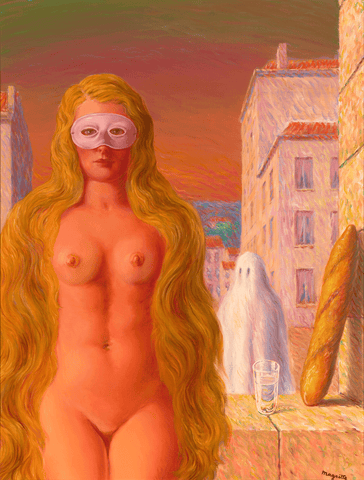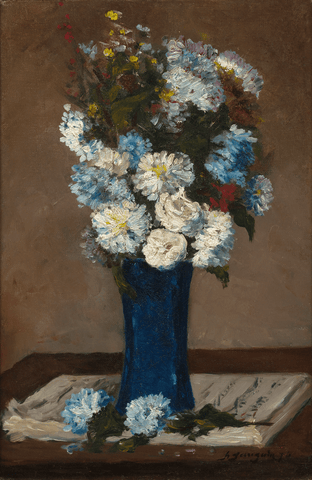Artists
Morisot, Berthe
"There are no lines in nature, only areas of color, one against another. Berthe Morisot has demonstrated this better than anyone." - Edouard Manet
Berthe Morisot is celebrated as one of art history’s leading 19th-century female artists. A member of the French Impressionists since the group's beginning, Morisot was the only female to exhibit at the first Impressionist exhibition in 1874. Although the prestigious École des Beaux-Arts denied women from attending, Morisot pursued her own art education and developed a style using long, loose strokes and rich coloring that helped define the Impressionism movement as a whole.
By 1864, Morisot submitted her first paintings to the Salon, acknowledging her ambitions to achieve respect and status as an artist. More driven by a quest for beauty and professional recognition than economic necessity, and following her mother’s advice to “follow the public’s taste if you want to succeed,” Morisot favored a careful and realistic approach to her paintings. Her preferred subjects included those with whom she was most intimate, such as her sisters and her closest friends.
Morisot, however, offered talent and value worthy of active participation and acceptance into the Impressionist world. Unlike her contemporaries who consistently captured landscape scenes painted en plein air, Morisot’s career was dominated by interior and domestic views of bourgeois Parisian women. By representing the intimate and secluded worlds of elite 19th-century women, Morisot granted viewers to settings often inaccessible to other painters, particularly her male counterparts.
From 1864 until 1873, Morisot exhibited regularly at the Paris Salons. In 1874, she joined the Société Anonyme Coopérative des Artistes Peintres, Sculpteurs, Graveurs — the group that would eventually become known as the Impressionists. They held their first exhibition that same year, and Morisot would go on to exhibit in all but one of the Société Anonyme’s shows.
The duo grew extremely fond of each other, perhaps even in love, according to some accounts. Nevertheless, Manet was married, and Morisot was careful to avoid any appearance of impropriety. Being his model already came with a certain amount of risk to her reputation, so her mother accompanied her to Manet's studio for her sittings.
Morisot's mother was anxious that she settle into a more conventional lifestyle and marry, but Berthe, devoted to her art, had rebuffed several suitors over the years. She was considered quite beautiful with her dark features and came from a well-connected family, but she was a freethinker who had put off marriage for her career. Finally, in 1874, perhaps as a way to remain connected to her friend and mentor, Morisot married Manet's younger brother Eugène who became her manager and promoted his wife's art enthusiastically. While she had never painted Edouard, she painted Eugène several times with their daughter, depicting him as kind, warm and fatherly.
Scholars agree that these depictions of women often show the subjects as they wanted to be seen and not as objects under the male gaze. To Morisot, these domestic spheres were enriched through the deep intellectual and internal lives of the women who embodied them. Morisot never trivialized her models or subjects. Although the artist undeniably worked within the conventions of her restrictive upper-class society, she had determination, ambition and independence of mind that led her to stray from many paths of convention.
Berthe Morisot is celebrated as one of art history’s leading 19th-century female artists. A member of the French Impressionists since the group's beginning, Morisot was the only female to exhibit at the first Impressionist exhibition in 1874. Although the prestigious École des Beaux-Arts denied women from attending, Morisot pursued her own art education and developed a style using long, loose strokes and rich coloring that helped define the Impressionism movement as a whole.
Early Life & Education
Born in Bruges, France in 1841, Berthe Morisot came from a wealthy family whose prestigious financial and social status allowed her the opportunity to pursue her artistic genius. Like most girls in her social class, she received private art lessons beginning at the age of eleven. Her parents built a home studio for both Morisot and her sister to explore, learn and create. Their art tutor, the painter Joseph Guichard, helped introduce her to the Parisian art scene.By 1864, Morisot submitted her first paintings to the Salon, acknowledging her ambitions to achieve respect and status as an artist. More driven by a quest for beauty and professional recognition than economic necessity, and following her mother’s advice to “follow the public’s taste if you want to succeed,” Morisot favored a careful and realistic approach to her paintings. Her preferred subjects included those with whom she was most intimate, such as her sisters and her closest friends.
Founder of a Movement
Natural, contemporary, spectacular and radical, the influence of 19th-century French Impressionism is nearly indescribable. Breaking from religious and static scenes that filled the French Academy, the Impressionists sought to capture the ephemeral, fleeting effects of Parisian bourgeoisie leisure life and the industrialization of France. These artists broke from academic practice and from the tradition of exhibiting at the public Salon, choosing to exhibit among like-minded pioneers of the burgeoning Impressionist movement. Dominated by a group of exclusively male painters, such as Claude Monet and Edgar Degas, few female artists were able to break into the close-knit circle of the Impressionist exhibitions.Morisot, however, offered talent and value worthy of active participation and acceptance into the Impressionist world. Unlike her contemporaries who consistently captured landscape scenes painted en plein air, Morisot’s career was dominated by interior and domestic views of bourgeois Parisian women. By representing the intimate and secluded worlds of elite 19th-century women, Morisot granted viewers to settings often inaccessible to other painters, particularly her male counterparts.
From 1864 until 1873, Morisot exhibited regularly at the Paris Salons. In 1874, she joined the Société Anonyme Coopérative des Artistes Peintres, Sculpteurs, Graveurs — the group that would eventually become known as the Impressionists. They held their first exhibition that same year, and Morisot would go on to exhibit in all but one of the Société Anonyme’s shows.
Famous Friendship
Edouard Manet and Berthe Morisot’s famous artistic partnership reveals a mutual understanding, respect and even love between the two great figures of the 19th century’s move toward modernism. Drawn together by a kindred artistic vision and spirit, the artists favored realism and authentic depictions of everyday life. Manet painted Morisot, his good friend and eventual sister-in-law, a total of twelve times — more than any other model — and kept a number of those paintings in his personal collection until his death.The duo grew extremely fond of each other, perhaps even in love, according to some accounts. Nevertheless, Manet was married, and Morisot was careful to avoid any appearance of impropriety. Being his model already came with a certain amount of risk to her reputation, so her mother accompanied her to Manet's studio for her sittings.
Morisot's mother was anxious that she settle into a more conventional lifestyle and marry, but Berthe, devoted to her art, had rebuffed several suitors over the years. She was considered quite beautiful with her dark features and came from a well-connected family, but she was a freethinker who had put off marriage for her career. Finally, in 1874, perhaps as a way to remain connected to her friend and mentor, Morisot married Manet's younger brother Eugène who became her manager and promoted his wife's art enthusiastically. While she had never painted Edouard, she painted Eugène several times with their daughter, depicting him as kind, warm and fatherly.
Emotional Sensitivity
Like her Impressionist colleagues, Morisot created art that was inseparable from her life. Unlike her male contemporaries, Morisot was often restrained to a domestic setting, and it was often unacceptable for her to explore the public theaters, bars, salons and parties that the other Impressionist painters frequented. As such, Morisot offered a unique perspective and point of view. Many of the paintings in her oeuvre depict women in their homes, often with their children or outside in garden settings.Scholars agree that these depictions of women often show the subjects as they wanted to be seen and not as objects under the male gaze. To Morisot, these domestic spheres were enriched through the deep intellectual and internal lives of the women who embodied them. Morisot never trivialized her models or subjects. Although the artist undeniably worked within the conventions of her restrictive upper-class society, she had determination, ambition and independence of mind that led her to stray from many paths of convention.









